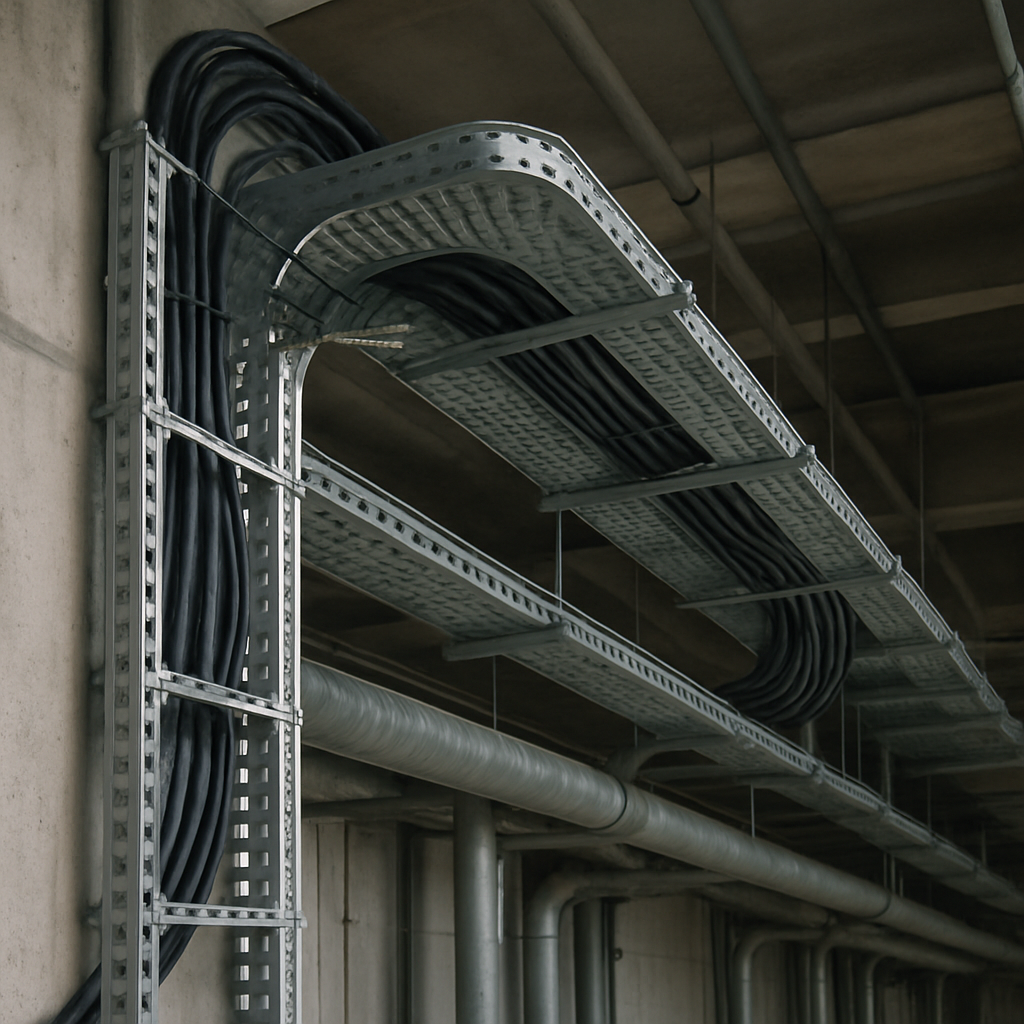In the world of electrical installations and industrial wiring, selecting the right cable management solutions is crucial. Proper cable management not only ensures safety but also enhances the efficiency and longevity of electrical systems. Two common types of wire support systems used in cable routing are cable trays and ladder racks. Understanding the difference between these two options can help in selecting the right solution for your power distribution needs.
Cable trays are structural systems used to support insulated electrical cables for power distribution, control, and communication. They offer a robust means of routing cables in various environments, from industrial to commercial settings.
Tipos de bandejas para cabos
- Solid Bottom Cable Tray: This type provides a continuous solid surface with side rails. It is suitable for minimal heat-generating applications and offers great cable protection.
- Esteira porta-cabos perfurada: Featuring a series of holes or slots, this type offers ventilation and is ideal for cables that generate more heat.
- Ladder Cable Tray: This resembles a ladder structure with two side rails connected by rungs. It provides superior air circulation, making it ideal for high-heat environments.
- Bandeja de cabos de malha de arame: This is a lightweight, flexible option used primarily in data centers and light industrial applications. It allows for easy cable management and changes.
Vantagens das Esteiras porta-cabos
- Flexibility: Cable trays can be customized to fit complex routing paths.
- Capacity: They can accommodate a large number of cables.
- Ease of Maintenance: Open designs allow for easy access during maintenance and inspection.
- Durability: Made from materials like steel, aluminum, or fiberglass, they are designed to withstand harsh conditions.
What is a Ladder Rack?
Ladder racks, on the other hand, are designed to support network equipment and cabling infrastructure, especially in data centers and telecommunication rooms. They are typically installed overhead and provide structured pathways for cable routing.
Features of Ladder Racks
- Open Design: The open-frame construction allows for maximum airflow around the cables, thereby reducing the risk of overheating.
- Modularity: Ladder racks are easy to expand or modify, accommodating future changes in cable routing needs.
- Load Capacity: They are designed to support substantial weight, making them suitable for heavy cabling installations.
Advantages of Ladder Racks
- Ventilation: The open design allows for optimal cable cooling.
- Accessibility: Easy access for installation and maintenance.
- Cost-Effective: Generally more affordable due to less material usage compared to solid structures.
Cable Tray vs. Ladder Rack: Key Differences
Application Suitability
Cable trays are versatile and can be used in a wide range of environments, including industrial settings where high-power distribution is needed. Ladder racks, however, are more suited for structured cabling systems like those found in data centers or IT environments.
Design e estrutura
Cable trays come in various designs, including solid, perforated, and wire mesh, each serving different purposes based on heat dissipation needs. Ladder racks have a more straightforward, open design that resembles a ladder, providing excellent ventilation and cable support.
Instalação e manutenção
Cable trays are often more complex to install due to their variety of designs and potential need for customization. However, they provide excellent support for heavy and extensive wiring systems. Ladder racks offer simpler installation and are easier to modify, which can be beneficial in environments where cabling needs frequently change.
Cost Considerations
While both systems offer cost-effective solutions for cable management, ladder racks typically require less material, making them more affordable upfront. Cable trays, with their diverse options and robust structure, may involve higher costs but offer greater versatility and protection.
Choosing the Right Cable Management Solution
When deciding between cable trays and ladder racks, consider the following factors:
- Environment: Assess the environment where the system will be installed. High-temperature or industrial settings may benefit more from the robustness of cable trays, while data centers might prefer the simplicity of ladder racks.
- Cable Volume and Type: Determine the volume of cables and the type of wires being routed. More extensive installations might require the capacity and protection offered by cable trays.
- Future Scalability: Consider potential future needs. If changes and expansions are anticipated, the modularity of ladder racks can be advantageous.
- Budget: Evaluate budget constraints. While ladder racks are generally more affordable, the long-term benefits of cable trays may justify the initial investment.
- Aesthetic and Functional Needs: In some settings, the appearance of the cable management system might be a consideration, especially in exposed installations.
Conclusão
Both cable trays and ladder racks serve essential roles in electrical installations and cable management. Understanding their differences helps in selecting the right system to ensure efficiency, safety, and longevity of your cabling infrastructure. Whether you prioritize flexibility, capacity, or cost, the decision ultimately depends on the specific requirements of your project.
By carefully evaluating your needs and the characteristics of each system, you can implement an effective cable management solution that supports your power distribution goals and adapts to future changes in your infrastructure.



